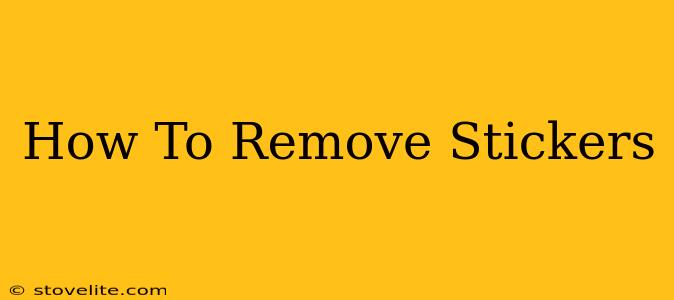Stickers. They're fun to put on, but removing them can be a real pain. That sticky residue left behind is frustrating, clinging to surfaces like a stubborn guest. But don't despair! This guide will equip you with the knowledge and techniques to remove stickers cleanly and effectively, leaving your surfaces looking pristine.
Understanding Sticker Removal Challenges
Before diving into removal methods, let's understand why stickers are so difficult to remove completely. The adhesive used in stickers is designed to be strong and long-lasting. This adhesive bonds tightly to various surfaces, making simple peeling often insufficient. The type of sticker, the surface it's applied to, and how long it's been there all play a significant role in the removal process.
Factors Affecting Sticker Removal:
- Sticker Material: Vinyl stickers are notoriously difficult, while paper stickers might be easier to manage.
- Surface Material: Smooth surfaces like glass are generally easier to clean than textured surfaces like wood.
- Adhesive Strength: Older stickers often have stronger, more stubborn adhesive.
- Exposure to Elements: Sun exposure can weaken the adhesive, making removal easier.
Effective Methods for Sticker Removal
Now, let's explore the most effective methods to remove stickers and tackle that pesky residue:
1. The Simple Peel:
This method works best for new, paper stickers on smooth surfaces. Gently lift a corner of the sticker and slowly peel it away at a low angle. If it starts to tear, stop and try another method.
2. Heat Application:
Heat softens the adhesive, making it easier to remove. Use a hair dryer on a low setting, holding it a few inches from the sticker. Apply heat for a few minutes, then try peeling. A heat gun (used cautiously!) can be more effective for stubborn stickers but requires more precision to avoid damaging the underlying surface.
3. The Ice Method:
For vinyl stickers, placing an ice cube on the sticker for a few minutes can make the adhesive brittle and easier to peel. Afterward, carefully scrape off the loosened sticker.
4. Isopropyl Alcohol (Rubbing Alcohol):
Isopropyl alcohol is a powerful sticker remover. Apply it to a cotton ball or microfiber cloth and gently rub it onto the sticker. Let it sit for a few minutes to penetrate the adhesive, then try peeling. Be sure to test on a small, inconspicuous area first, especially with delicate surfaces.
5. WD-40:
WD-40 can also work wonders, particularly on stubborn stickers. Spray it lightly onto the sticker, wait a few minutes, and then peel. This method should also be tested on a hidden area first. Remember to clean the surface thoroughly afterward as WD-40 can leave a residue.
6. Commercial Sticker Removers:
Various commercial sticker removers are available at hardware stores and online. These often contain solvents designed to dissolve sticker adhesive. Always follow the manufacturer's instructions.
Removing Sticker Residue
Even after removing the sticker, residue might remain. Here’s how to tackle it:
- Goo Gone: This product is specifically designed for removing sticky residue.
- Baking Soda Paste: Make a paste of baking soda and water, apply it to the residue, and gently scrub.
- White Vinegar: Soak a cloth in white vinegar and apply it to the residue. Let it sit for a few minutes before wiping clean.
Tips for Preventing Future Sticker Residue Issues:
- Use removable stickers: Choose stickers specifically designed for easy removal.
- Apply stickers carefully: Ensure proper alignment to avoid lifting and repositioning, which can increase adhesive residue.
- Clean the surface before applying stickers: Dust and debris can interfere with adhesion and make removal more difficult.
Removing stickers doesn't have to be a frustrating experience. By following these steps and selecting the right method for the sticker and surface, you can achieve clean, residue-free results. Remember to always test any cleaning solution on an inconspicuous area first to avoid damage. Happy sticker removal!

